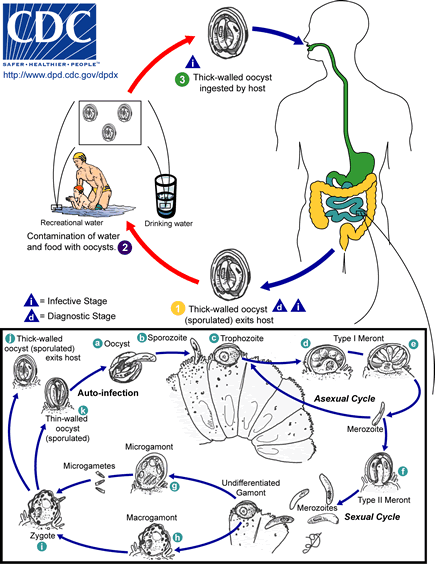Introduction to Diagnostic Medical Parasitology
Essentials
Cryptosporidium parvum is an intestinal sporozoan parasite. Cryptosporidiosis occurs sporadically in humans and is - as a rule - a self-limiting infection. It can become a severe disease in immunocompromised patients. Infection sites are within the gastrointestinal, biliary and respiratory tracts.


Epidemiology
- Distributed worldwide, especially in developing countries
- Infection occurs by per oral uptake of oocysts in contaminated water
- Infection is common in many animals, which represent a large reservoir
- Various transmission modes: faecal-oral (water and food-borne transmission), person-to-person or animal-to-person
Pathology
- Parasitic infection of the human gastrointestinal, biliary and respiratory tracts (cryptosporidia form an attachment zone and may replace microvilli)
Clinical Findings
Asymptomatic infections are common!
Especially in AIDS patients, severe clinical courses are seen contributing to death.
Observed symptoms:
- Watery diarrhoeas
- Abdominal pain
- Fever
- Malaise
- Weight loss

Diagnosis
Diagnostic methods
Parasitological methods
Oocysts are detected in formalin- or SAF-fixed (to limit infection risk of laboratory personnel) concentrated faeces using a modified Ziehl-Neelsen stain, auramine or FITC-labelled specific monoclonal antibodies.
The number of oocysts is inversely correlated with the consistency of the stool.
Molecular diagnosis
Comparative analysis of a nested PCR did not reveal a higher sensitivity than the direct fluorescent antibody or the antigen EIA test.
A recently described multiplex real-time PCR assay detects simultaneously Cryptosporidium, Giardia and Entamoeba.
Antigen detection
Several commercially available test kits detect Cryptosporidium copro-antigens in faecal samples by immunochromatographic, immunoenzyme or direct fluorescent antibody assays.
Antibody detection
Of no diagnostic relevance!
Diagnostic strategies
- To diagnose an individual case
Molecular diagnosis or antigen detection are the methods of choice today. Parasitological diagnosis after special staining or with the use of fluorescent agents is still an option if an experienced microscopist is available.
- To screen exposed populations
Rapid antigen detection assays are the most convenient tests for field use.

Prevention and control
- Education in personal hygiene
- Exclusion of infected children from day care facilities